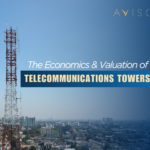
One source of growth in the Philippines is data consumption, brought about by an expansion of e-commerce and enabling financial technologies. Segments of the real estate sector that are positively-affected by this trend include logistics hubs (fulfillment centers) and data centers. However, one other growth area not typically covered in real estate news is that of telecommunications towers.
Telecommunication, or telecom, towers are the backbone of modern communication networks, providing the infrastructure necessary for wireless communication across vast distances. These towering structures may seem simple at first glance, but they are complex systems designed to facilitate the seamless transmission of voice and data signals.
There are four main types of telecommunication towers:
1. Lattice Towers: Characterized by their lattice-like structure, which offers flexibility and self-supporting capabilities. They are commonly used in areas with high wind loads and can accommodate multiple antennas.
2. Monopole Towers: Consist of a single vertical pole. They are aesthetically pleasing and blend well with urban environments. Monopole towers are usually found in densely populated areas where space is limited.
3. Guyed Towers: Constructed with a central mast and guy wires that provide additional stability.
4. Stealth Towers: Designed to blend into their surroundings, making them ideal for use in areas where aesthetics is a concern.
The components of a telecommunication tower include antennas, transceivers, baseband units, power sources, cabling, and shelters, all working together to transmit and receive signals. Telecom tower design, installation, maintenance, and optimization are influenced by factors such as signal coverage requirements, geographical terrain, transmitter power, frequency band, antenna height, and network capacity.
Safety standards and future trends, such as the transition to 5G technology and the incorporation of small cells, are also important considerations. Understanding the intricacies of telecommunication towers is crucial for professionals in the field, as they play a pivotal role in ensuring reliable network coverage.
Coms Tower Business Model
Telecom towers generate income primarily through leasing shared tower space to telecommunications providers. Here are the key ways they generate revenue:
 Leasing Space: The towers are typically owned and operated by dedicated companies. These companies generate income primarily through leasing shared tower space to telecommunications providers, such as Globe, Smart and other companies. This makes the tower companies effectively an owner of a difficult-to-replicate asset.
Leasing Space: The towers are typically owned and operated by dedicated companies. These companies generate income primarily through leasing shared tower space to telecommunications providers, such as Globe, Smart and other companies. This makes the tower companies effectively an owner of a difficult-to-replicate asset.
Growth Potential: Increasing the number of sites and/or getting more equipment onto those sites is a key value driver. Network coverage and densification are two main areas of organic lease revenue growth. High multiples have been achieved partly because of 5G requirements (additional/larger antennas) and partly due to rural coverage obligations of existing Mobile Network Operators (MNOs), which continue to drive network roll-out and growth.
Infrastructure Sharing: Growth for independent tower companies is being underpinned by the trend for outsourcing tower infrastructure. Increasing the number of customers siting equipment on each tower is the main growth driver behind the high multiples being paid.
Rental Income: A cell tower will generate rental income for you, your family, or your business. Most tenants are billion-dollar telecommunication companies that will pay on time and for decades into the future. Moreover, the rent will escalate as the years go by.
In the US market, on average, a cell tower generates $68,700 in revenue per year, and the monthly subtenant/co-locator (person whose property the tower is situated upon) is paid $1,880-$2,874 per month.
Telecoms Tower Income in the Philippines
Telecommunication tower lease rates in the Philippines can vary greatly depending on several factors such as the location of the tower, the size of the land, the population density of the area, and the specific terms of the lease agreement. A telecommunications tower installed strategically on top of a tall office building, can hypothetically reach millions of potential subscribers in a dense urban area. Such a tower will have enormous value as an investment property.
As an investment property, a telecoms tower can be assigned to a Real Estate Investment Trust, or REIT. A REIT is a company that owns, operates, or finances income-generating real estate. Modeled after mutual funds, REITs pool the capital of investors to earn dividends from real estate investments.
And yet more common asset financial arrangement in the Philippines is an equipment or real estate lease-buyback, or finback. In this scenario, an owner sells their property or equipment to a leasing company for cash. The leasing company then leases the same property or equipment back to the original owner. This allows the owner to free up capital while still being able to use the property or equipment.
While there are no publications or open public resources for lease rates of telecommunications towers in the Philippines, these can be indirectly inferred-to from some sources.
A Reddit thread mentioned that Globe was renting a tower for PhP17,833.14 per month in a 2nd class municipality in western Mindanao. Another Reddit user mentioned a rent of PHP 18,000 per month in Silang, Cavite. Yet another user mentioned a rent of PhP20,000 per month with a 3% yearly increase in Pasay, Manila. Comitcore.com mentioned that the rent of a tower was Ph/P10,000 per month.
It is evident that the lease rate depends on location with correlation to density of the population within the tower transmitters’ reach. However, between similar towers, the magnitude of the difference does not appear to be substantial.
In a news article, Globe Telecom Inc. announced it signed two sale and lease back deals involving over 5,000 telecom towers for PhP71 billion (or PhP14.2 million per tower). The first deal was with MIESCOR Infrastructure Development Corporation (MIDC) for the sale of 2,180 telecom towers and passive telecom infrastructure for over PhP26 billion (or PhP11.9 million per tower). The second transaction involved 3,529 telecom towers sold to Frontier Tower Associates Philippines Inc. for PhP45 billion (or 12.75 million per tower). These are the smaller towers that one often sees on top of hills, empty lots or on top of buildings. The towers cover a few kilometers within urban areas but may service tens of kilometers in rural areas where there is less demand for bandwidth.
According to an article in Business Inquirer, the ideal ratio for a telecoms tower is 1,200 subscribers each. Given this metric and using the average cost per tower of PhP13 million per tower, a telecoms company invests PhP10,833.33 per subscriber. However, this is an ideal metric based on a radio engineer. The reality is that telecom firms allow for higher concentration and bandwidth usage in an area to maximize their investments. A telecoms tower servicing 1,500 to 2,000 subscriber is likely typical and there can be cases of higher concentration. A telecoms company would start investing in additional bandwidth infrastructure to avoid subscribers migrating to competitor networks due to sluggish upload and download speeds due to congestion, however.
So far, however, this discussion has focused on a small or mid-sized tower that can service one telecom service provider. Many modern telecom towers are designed to accommodate multiple transponders and other equipment. For example, in the Philippines, the “common tower” policy by the National Telecommunications Commission, or NTC, allows more than one telecom company to use a single tower, thereby increasing the number of subscribers being served by each tower. Hypothetically, a large telecommunications tower installed on top of an office skyscraper can reach thousands of households for many square kilometers, hosting transponders for multiple service providers and even terrestrial broad cast signals for radio and free-to-air television. A large tower can therefore generate a large rental income for its owner or lessor.
Valuation
A telecommunications tower can earn leasing income based on how many potential subscribers, listeners, and viewers it can reach. The lease rate is often based on a price per subscriber. Less the operating expenses of the tower yields a pre-tax net income, which can be projected and capitalized to present value to arrive at an income value under the income approach framework and the DCF methodology.
And whereas there are not a lot of published data on the value of operating telecoms towers, in the rare cases of areas in the Philippines where such data is available, it is also possible to value using the market comparison approach with such factors as reach and technology serving as major value factors for adjustments.
It is also tempting to arrive a valuation using simple multiples of potential subscribers covered as simpler and faster way to value. However, this approach may serve better as a sanity check on more conventional market and income approach methods.
In general, however, because of the lack of market data and the fact that telecommunications towers differ widely from one another based on construction type, technology and coverage, the income approach is the better gauge for the valuation of telecommunications towers.
Written By: Roque M. Sorioso, Jr.
Aviso Valuation and Advisory Corp. is a real estate consultancy firm that offers valuation and business advisory services compliant to international standards such as the International Valuation Standards (IVS) and International Financial Reporting Standards (IFRS). To assure that we only produce high-quality deliverables, as needed, we do tasks beyond the usual appraisal process like verifying pertinent property documents (i.e. land titles, tax declarations, etc.) with the appropriate government agencies for due diligence purposes prior to the acquisition of the properties.
Sources
1. Monthly rent for telecom towers in the Ph : r/phinvest – Reddit. https://www.reddit.com/r/phinvest/comments/14vsyst/monthly_rent_for_telecom_towers_in_the_ph/.
2. Magellan Group.com
3. Globe sells and leases back over 5,000 telecom towers for P71B. https://www.gmanetwork.com/news/money/companies/841333/globe-sells-and-leases-back-over-5-000-telecom-towers-for-p71b/story/.
4. Cell tower in the Philippines – CELL PHONE TOWERS. https://www.cell-phone-towers.com/cell-tower-in-the-philippines.html.
5. Unity Digital Infrastructure, Inc.. https://www.unitydigitalinfra.com/.
6. Fibercom Telecom Phils.. https://fibercomtelecoms.com/.
7. Globe Telecom Gmcr. https://www.globe.com.ph/.
8. Comit Telecom Philippines. https://comitcorp.com/.
9. Leasing Land to a Telecommunications Company to Build a Tower. https://www.investopedia.com/ask/answers/122314/if-telecommunication-company-wants-build-tower-my-land-how-much-should-i-charge.asp
10. Cell Tower Lease (Rates, Agreements, Buyout, Value) – Dgtl Infra. https://dgtlinfra.com/cell-tower-lease-rates-agreements/.









